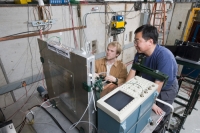 |
 |
|||||||||||||
|
|||||||||||||
|
|||||||||||||
|
Peeling paint? Leaky roof? No problem. Say the words “test beam facility” to a physicist, and the opportunity to collect real physics data will wash away any aesthetic issues. Literally. This is at least how a team of Fermilab users from University of Texas at Arlington, Lousiana Tech University and Changwon National University in South Korea, reacted to the opportunity to test their ILC detector prototype in the Meson Test Beam Facility. “The setup in the test facility is great,” said Jae Yu of the University of Texas - Arlington,
Last week the team of physicists and graduate students drove their 30 cm by 30 cm Gas Electron Multiplier chamber prototype all the way from Texas to test it in the pion and proton beam for seven days. The Gas Electron Multiplier, or GEM, is a particle detector technology that the team proposes for the digital hadron calorimeter in the ILC SiD and other ILC detector concepts. Physicists find the technology appealing because GEM-based detectors can provide large gain, and handle high rates with high efficiency. These detectors are robust and can track charged particles accurately - an essential ingredient for an ILC digital hadron calorimeter. A member of the CALICE Collaboration, the University of Texas team will use their time in the Meson facility to test their GEM prototype and measure its responses, efficiencies, cross-talk, occupancy rate and signal read-out rate capabilities. Using a movable table, the team will move the prototype to test different areas of the chamber in the beam. “This allows us to measure properties of the chamber in different areas without interference to beam operations,” Yu said. “It is a big deal for large detectors to make sure that all of the parts work consistently, and this test will teach us an incredible amount.” In addition to studying ILC detector technology, the team is also testing a GEM prototype for medical applications. While conducting tests on detector prototypes at UTA, a visiting scientist from Changwon National University learned that GEMs are sensitive to xrays. “It could read the signal out and display it in real time as you get exposed to the X-rays,” Yu said. As for the ILC digital hadron calorimeter, the medical applications will also require further development but the team believes that the potential is there. The GEM prototype test is the first in a series of beam tests that the University of Texas at Arlington team has planned. Next the team will conduct a large scale electronics test (called the Slice Test) run jointly with Argonne National Laboratory's RPC (Resistive Plate Chamber) detector and other teams. The teams would then like to build a cubic metre prototype that will consist of 40 planes of RPC and/or GEM and 400,000 readout channels. (The current prototype has 900 readout channels.) Plans for building this next large prototype will depend on funding, but the current small prototype will provide valuable information by allowing physicists to see how it reacts in an actual beam. An ILC detector digital hadron calorimeter would require ultimately 4,000 square metres of GEM foil -- approximately 45,000 times larger than the team's prototype. “This beam test is a baby step toward getting the actual ILC detector built,” Yu said. -- Elizabeth Clements |
|||||||||||||
| © International Linear Collider |
